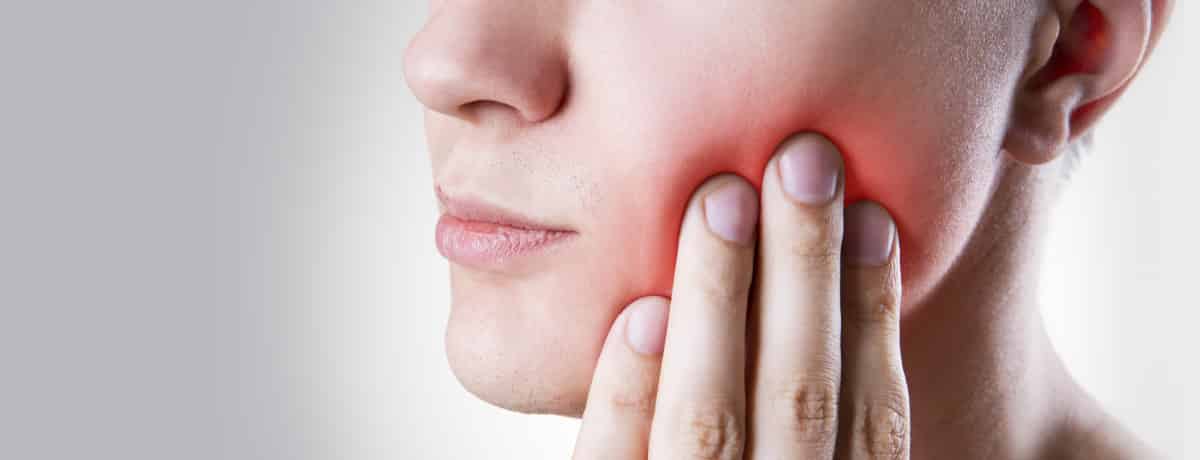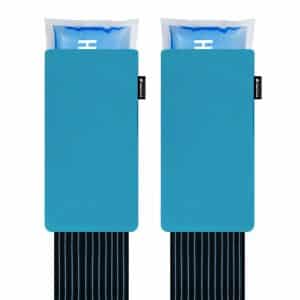
Wear in Jaw (Jaw Osteoarthritis) | Cause, diagnosis, symptoms, exercises and treatment
Have you got any wear and tear on your jaw (osteoarthritis)? Here you can learn more about jaw joint wear, as well as associated symptoms, cause, exercises and various diagnoses of jaw wear. Follow and like us too Our Facebook page for free, daily health updates.
The jaw, like other joints in the body, can be affected by wear and tear. Wear of the jaw is called jaw osteoarthritis in the medical professional language. Osteoarthritis means joint wear and is composed of the words arthro (joint in Latin) and -ose, where the latter indicates wear changes.
Osteoarthritis is also called osteoarthritis - although in recent times the use of "gout" has been increasingly abandoned.
If you have long-term pain in the jaw, we strongly recommend that you consult a public health professional, such as a doctor, physiotherapist or modern chiropractor for examination and any treatment.
Are you wondering something or do you want more of such professional refills? Follow us on our Facebook page «Vondt.net - We relieve your pain»For daily good advice and useful health information.
Symptoms of jaw joint wear
Wear and tear on the jaw and the joint will not always cause symptoms. In fact, the vast majority of cases of osteoarthritis are asymptomatic and do not cause pain - but then you also have several cases that cause local pain in the jaw joint and associated jaw muscles. It is especially the latter, that is, the musculature, which most often provides the basis for jaw pain and such overactivity can occur, among other things, to compensate for a worn synovial joint. The jaw also has a meniscus, similar to the knee, and this may also cause pain due to meniscus irritation or meniscus injury.
Common symptoms of jaw wear may overlap with other functional and structural jaw diagnoses, and may include:
- A feeling that the jaw joint is not correctly positioned or in the wrong position.
- Jaw and neck go hand in hand: With this we refer to the fact that dysfunction in the jaw can cause pain in the upper part of the neck, and vice versa. This is especially true of the upper neck joints, as their movement directly affects your jaw movement when you chew and bite.
- Buttoning in the jaw when chewing or gaping.
- Pain in the jaw when bitten.
- Clear pressure tenderness when touching the jaw joint or associated jaw muscles.
- Uneven chewing movement and a feeling that the joint rubs bone against bone.
Causes: Why do I have osteoarthritis in my jaw?
Joint wear normally occurs in everyone over the years. In other words, time causes degenerative changes in the jaw joint - including changes in the bone structure (weaker skeleton), repetitive strain and degradation of the jaw meniscus.
But, what many do not know is that muscular imbalance in the jaw muscles is often one of the main reasons why the jaw joint is overloaded - and thus microtrauma is inflicted which over time can lead to wear and tear in the joint and meniscus damage.
Trauma, such as being hit in the jaw or falling on the jaw, can cause damage to the meniscus and synovial joint. If the trauma is severe, this can also result in fracture of the jawbone or skull. Examples of such trauma may be that someone is subjected to violence and punched in the face, or that it happens on a sports court (for example, that a football player gets an elbow in the jaw when going up in a head duel).
To summarize - the common causes of wear and tear in the jaw are:
- Age-related wear
- Muscular imbalance
- Traumatic wear and tear
Also read: - Are you suffering from Jaw Headaches?
diagnoses
We previously divided the symptoms from the joint, musculature or meniscus - we will do the same here when we list diagnoses.
Joint:
- Osteoarthritis of the jaw (wear and tear in the jaw joint)
- TMD (temporomandibular dysfunction)
Meniscus:
- Meniscus irritation in the jaw
- Meniscus injury in the jaw
musculature:
- Masseter myalgia (muscle pain from the large masticatory muscle - also known as musculus masseter in Latin)
- Musculus digastricus myalgi
- Muscular imbalance (too strong muscles versus too weak muscles elsewhere, which thus leads to incorrect loading in the jaw joint)
- Jaw lock (locked jaw)
- Jaw myalgia (overexertion / muscle pain in the jaw)
- Myalgia of the lateral or medial pterygoideus
Do not let anyone tell you that jaw symptoms and jaw diagnoses can not be treated - because they certainly can.
Treatment
When treating wear of the jaw, the main purpose is to optimize the function and the muscular balance in the jaw region.
Any treatment plan should always start with an examination by a publicly authorized clinician with expertise in muscles, nerves and joints. The three publicly authorized professions in Norway are physiotherapist, chiropractor and manual therapist - this means that they are regulated by the Norwegian Directorate of Health and that their titles are protected in accordance with Norwegian law. Such a clinical examination will address movement patterns, functional tests and testing of muscles and joints.
For best results, active therapy should be combined with home exercises (exercise program for the jaw muscles according to the findings made by the clinician).
The most common in relation to muscular imbalance in the jaw is that the muscles that bite down and move the upper jaw forward (masseter + the two pterygoideus) are stronger (and tighter) than the one who has the main responsibility for pulling the lower jaw forward (digastricus). A popular home exercise to correct this imbalance is "tongue against the ceiling of the oral cavity" - which simply involves sticking your tongue against the ceiling of the oral cavity and holding the position for about 30 seconds and then repeating over 3-4 sets.
- Active treatment methods
A clinician can treat and treat muscular symptoms and dysfunction of the jaw joint. This can be done in several ways, including:
- Intramuscular needle treatment (medical acupuncture / dry needle): Dry needle aimed at overworked and painful muscles in the jaw can contribute to increased blood circulation, less pain signals and improved jaw movement. By reducing overexertion in the muscles that "pull" the joint in the "wrong direction", you can help restore a more correct use of the muscles.
- Joint mobilization and joint traction (usually performed by a chiropractor or manual therapist): Joint treatment stimulates increased joint movement and can contribute to a more correct chewing and bite function.
- Muscular trigger point treatment (muscle knot treatment): This form of treatment specifically involves manual pressure against pain-sensitive and overactive muscle attachments and muscle knots. In the same way as dry needling, this helps to increase local blood circulation, as well as lower overactivity in painful muscles.
We encourage assessment and treatment via a publicly authorized clinician (manual therapist, chiropractor and physiotherapist - on an equal footing with a doctor), as it is these professions that are protected and regulated by Norwegian law. This means that you know what to expect in relation to their education, adherence to clinical guidelines and title. Non-publicly authorized professions (such as naprapath, osteopath and homeopath) are not protected by title and mean that it is not illegal to call yourself this (even without education).
Exercises against Wear in Jaw
When it comes to jaw exercises and exercises against joint wear in the jaw, we primarily talk about training that helps to contribute to the best possible function of the jaw joint and associated muscles.
If the muscles in the jaw are strong enough - and you train this regularly - then you can prevent and prevent worsening of wear and tear in the jaw. The muscles will relieve the joints and thus reduce the load that goes through the synovial joint.
Here is an overview of exercises you can use:
Click on the links above to see the different training programs.
Read more: Spinal stenosis - when the nerves get pinched!
Summarizeringing
Wear and tear in the jaw can lead to pain, but it can also be asymptomatic. Such joint wear is often related to a number of factors - which include age-related wear, trauma or muscular imbalance (lack of stability muscles can involve an increased risk of joint damage and meniscus damage).
Do you have questions about the article or do you need more tips? Ask us directly via our facebook page or via the comment box below.
Recommended self help
Reusable Gel Combination Gasket (Heat and Cold Gasket): Heat can increase blood circulation to tight and sore muscles - but in other situations, with more acute pain, cooling is recommended, as it reduces the transmission of pain signals.
Read more here (opens in new window): Reusable Gel Combination Gasket (Heat & Cold Gasket)
NEXT PAGE: - This You Should Know About Jaw Pain
Click on the image above to proceed to the next page. Otherwise, follow us on social media for daily updates with free health knowledge.
 Follow Vondt.net on YOUTUBE
Follow Vondt.net on YOUTUBE
(Follow and comment if you want us to make a video with specific exercises or elaborations for exactly YOUR issues)
 Follow Vondt.net on FACEBOOK
Follow Vondt.net on FACEBOOK
(We try to respond to all messages and questions within 24-48 hours. We can also help you interpret MRI responses and the like.)






Leave a reply
Want to join the discussion?Feel free to Contribute!